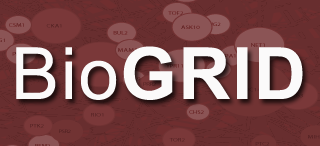
The Korarchaeota is a proposed phylum within the Archaea. The name is derived from the Greek noun koros or kore, meaning young man or young woman, and the Greek adjective archaios which means ancient. They are also known as Xenarchaeota. The name is equivalent to Candidatus Korarchaeota, and they go by the name Xenarchaeota or Xenarchaea as well.

A curator is a manager or overseer. When working with cultural organizations, a curator is typically a "collections curator" or an "exhibitions curator", and has multifaceted tasks dependent on the particular institution and its mission. The term "curator" may designate the head of any given division, not limited to museums. Curator roles include "community curators", "literary curators", "digital curators", and "biocurators".

Pfam is a database of protein families that includes their annotations and multiple sequence alignments generated using hidden Markov models. The most recent version, Pfam 36.0, was released in September 2023 and contains 20,795 families.

The short-nosed bandicoots are members of the order Peramelemorphia. These marsupials can be found across Australia, although their distribution can be patchy. Genetic evidence suggests that short-nosed bandicoots diverged from the related long-nosed species around eight million years ago, during the Miocene epoch, and underwent a rapid diversification around three million years ago, during the late Pliocene.

The Biological General Repository for Interaction Datasets (BioGRID) is a curated biological database of protein-protein interactions, genetic interactions, chemical interactions, and post-translational modifications created in 2003 (originally referred to as simply the General Repository for Interaction Datasets by Mike Tyers, Bobby-Joe Breitkreutz, and Chris Stark at the Lunenfeld-Tanenbaum Research Institute at Mount Sinai Hospital. It strives to provide a comprehensive curated resource for all major model organism species while attempting to remove redundancy to create a single mapping of data. Users of The BioGRID can search for their protein, chemical or publication of interest and retrieve annotation, as well as curated data as reported, by the primary literature and compiled by in house large-scale curation efforts. The BioGRID is hosted in Toronto, Ontario, Canada and Dallas, Texas, United States and is partnered with the Saccharomyces Genome Database, FlyBase, WormBase, PomBase, and the Alliance of Genome Resources. The BioGRID is funded by the NIH and CIHR. BioGRID is an observer member of the International Molecular Exchange Consortium.

The Pathogen-Host Interactions database (PHI-base) is a biological database that contains manually curated information on genes experimentally proven to affect the outcome of pathogen-host interactions. The database has been maintained by researchers at Rothamsted Research and external collaborators since 2005. PHI-base has been part of the UK node of ELIXIR, the European life-science infrastructure for biological information, since 2016.
The MetaCyc database is one of the largest metabolic pathways and enzymes databases currently available. The data in the database is manually curated from the scientific literature, and covers all domains of life. MetaCyc has extensive information about chemical compounds, reactions, metabolic pathways and enzymes. The data have been curated from more than 58,000 publications.
Mouse Genome Informatics (MGI) is a free, online database and bioinformatics resource hosted by The Jackson Laboratory, with funding by the National Human Genome Research Institute (NHGRI), the National Cancer Institute (NCI), and the Eunice Kennedy Shriver National Institute of Child Health and Human Development (NICHD). MGI provides access to data on the genetics, genomics and biology of the laboratory mouse to facilitate the study of human health and disease. The database integrates multiple projects, with the two largest contributions coming from the Mouse Genome Database and Mouse Gene Expression Database (GXD). As of 2018, MGI contains data curated from over 230,000 publications.

Chelis is a genus of tiger moths in the family Erebidae. There are more than 30 described species in Chelis, found in the holarctic.
Digital curation is the selection, preservation, maintenance, collection, and archiving of digital assets. Digital curation establishes, maintains, and adds value to repositories of digital data for present and future use. This is often accomplished by archivists, librarians, scientists, historians, and scholars. Enterprises are starting to use digital curation to improve the quality of information and data within their operational and strategic processes. Successful digital curation will mitigate digital obsolescence, keeping the information accessible to users indefinitely. Digital curation includes digital asset management, data curation, digital preservation, and electronic records management.
Oscar Peter Buneman, is a British computer scientist who works in the areas of database systems and database theory.
Data curation is the organization and integration of data collected from various sources. It involves annotation, publication and presentation of the data so that the value of the data is maintained over time, and the data remains available for reuse and preservation. Data curation includes "all the processes needed for principled and controlled data creation, maintenance, and management, together with the capacity to add value to data". In science, data curation may indicate the process of extraction of important information from scientific texts, such as research articles by experts, to be converted into an electronic format, such as an entry of a biological database.
Mycobacterium lepromatosis is an aerobic, acid-fast bacillus (AFB), and the second known causative agent of Hansen's disease (leprosy). It was discovered in 2008. Analysis of the 16S rRNA gene confirms that the species is distinct from Mycobacterium leprae.
Leptotrichia goodfellowii is a Gram-negative, non-spore-forming and non-motile anaerobic bacterium from the genus of Leptotrichia which has been isolated from human blood of an endocarditis patient. It is associated with infections in the oral cavity and respiratory tract. While primarily associated with opportunistic infections in immunocompromised individuals, its exact pathogenic mechanisms and clinical significance warrant further investigation.

The curation of extraterrestrial samples (astromaterials) obtained by sample-return missions takes place at facilities specially designed to preserve both the sample integrity and protect the Earth. Astromaterials are classified as either non-restricted or restricted, depending on the nature of the Solar System body. Non-restricted samples include the Moon, asteroids, comets, solar particles and space dust. Restricted bodies include planets or moons suspected to have either past or present habitable environments to microscopic life, and therefore must be treated as extremely biohazardous.
Biocuration is the field of life sciences dedicated to organizing biomedical data, information and knowledge into structured formats, such as spreadsheets, tables and knowledge graphs. The biocuration of biomedical knowledge is made possible by the cooperative work of biocurators, software developers and bioinformaticians and is at the base of the work of biological databases.
Mycena indigotica is a species of fungus. It was described for the first time in 2018 by Chia Ling Wei and Roland Kirschner after its discovery on the North-western Pacific Island of Taiwan. The genus Mycena is most famous for containing the majority of described bioluminescent fungi. However, M. indigotica is one of the many non-bioluminescent species within the genus. Nonetheless, this mushroom is aesthetically striking, with a petite and novel morphology.

Trichoderma atroviride is a filamentous fungal species commonly found in the soil. This fungal species is of particular interest to researchers due to the plethora of secondary metabolites it makes which are used in industry The genus Trichoderma is known for its ubiquity in almost all soils and being easy to culture. Many Trichoderma's are also avirulent plant symbionts.









